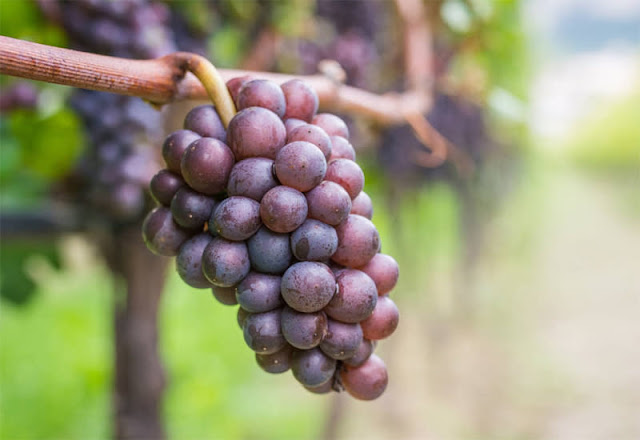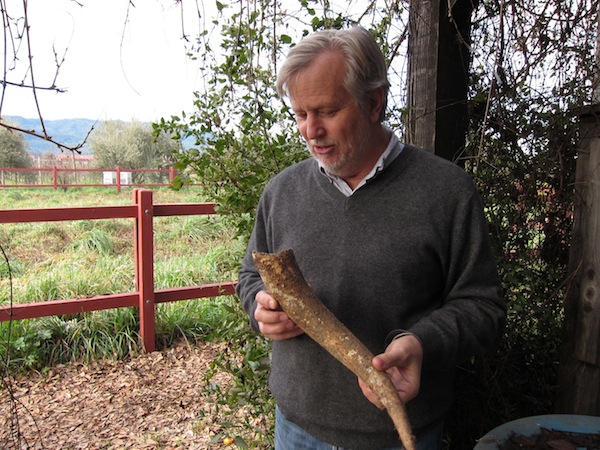King Estate Domaine Pinot Gris and saffroned seafood risotto
 |
| Pinot gris, a.k.a., Pinot grigio |
In Italy the Pinot gris grape is called Pinot Grigio, and there it yields delightfully fresh, easy drinking dry white wines, in boatloads of quantity. As catchy, ubiquitous, or maybe annoying, as ABBA.
In France’s Alsace region, the grape is called Pinot Gris (yes, it’s a gris or “gray” mutation of the Pinot Noir grape), and there it is turned into fuller, softer, and considerably more viscous, minerally and aromatic white wines than that of Italy. Often as deep, multi-faceted, and crescendoing as, say, Antonin Dvorák.
In Oregon – probably the only other place on earth where the reddish-gray skinned Pinot is grown with import – the resulting white wines are usually as full as that of Alsace, as lively and tart edged as Italy’s, yet with its own, unique indentations on the grape profile. As bright, fresh, full and fragrant as, say, the Lovin’ Spoonful's You and Me and Rain on the Roof.
 |
| King Estate. |
Case in point: the 2007 King Estate Oregon Domaine Pinot Gris (about $25). If you know the Northwest, you can smell the after-spring-shower damp leaves behind its peaches, cream and citrus blossom nose, and taste the juicy fall apples – like a wet, damp kiss – in its full yet lively, fluid, citrus-crisp flavors, veiled in a sumptuous, creamy texture.
From the beginning the King family’s vineyards were farmed sustainably for the long-term benefits of ecological balance; and in 2002 the estate was certified organic by the rigorous third party standards of OTCO (Oregon Tilth Certified Organic). Yet in 1991, when King Estate first broke ground on its 1,033 estate and 110,000 square foot winery at the bottom edge of Oregon’s Willamette Valley, southwest of Eugene, there was plenty of fear and trepidation among the locals.
 |
| King Estate vineyard manager, Meliton Martinez. |
After all, Oregon was, and still is, the home of the small, handcraft winery, almost by definition. At the time, longtime, nationally known producers such as Eyrie, Rex Hill, and Adelsheim never produced much more than 10,000,14,000 or 20,000 cases respectively; whereas King Estate was built to produce over ten times those amounts.
Despite these anxieties, the vines in King Estate’s home vineyard began to mature to the point where, today, they are producing wines that are pretty much the class of Oregon grown Pinot Gris, and therefore of the U.S.; since nowhere else in the U.S. does Pinot Gris grow to produce a wine with as much classic finesse to match the grape’s fragrant, transparent freshness. As with all great wine regions, it comes down to terroir: King Estate's cool Northwest climate, and gently rolling, well drained slopes at 800-1,200 ft. elevations. And with 465 acres planted, it is one of the largest, single, contiguous organic vineyards in the world.
Wines as finely balanced as King’s Domaine Pinot Gris are easy matches for virtually any “white wine dish,” but if I were to choose one, I’d choose some variation of a saffron laced risotto with seafood (re this easily adjustable recipe for a saffroned shrimp risotto) for several reasons: the citrusy acidity of the wine is particularly refreshing with shellfish; the creamy texture of rice cooked in butter and stock strikes a luscious note of similarity with the silkiness of the wine; and the earthy, briny, organic notes of saffron strike a resounding chord with the naturally minerally, damp earth qualities of the grape.
So why ask why? Just enjoy!




Comments
Post a Comment